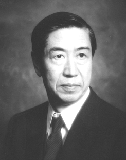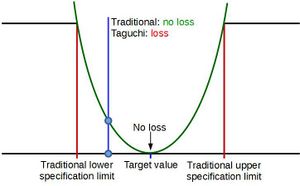Genichi Taguchi
Genichi Taguchi (Jan 1, 1924 - June 2, 2012) was an Japanese engineer and statistican, who applied statistical methods to manufacturing of goods.
Takamachi, city where Taguchi was born, was famous for the kimono industry. His family expected him to study textile engineering, but due to World War II he had to stop studying. After war he changed interests and started to study statistics.
He worked for Japanese Ministry of Public Health and Welfare, where he started to work on design of experiments idea. As Kaoru Ishikawa, he was under the influence of William Edwards Deming. He gained experience while working for Electrical Communications Laboratory for 12 years. After this, he began to consult in Japanese industry. At that time, he also worked as a visiting professor in Japanese and American institutes. In 50-ties he worked in Indian Statistics Institute with Walter A. Shewhart.
Taguchi's ideas are widely used today in many industries. Due to level of sophistication, they are often less known than achievements of Deming, Juran or Ishikawa.
Biography
- 1942 - Astronomical Department of the Navigation Institute of the Imperial Japanese Navy
- 1948 - work in Ministry of Public Health and Welfare and Institute of Statistical Mathematics
- 1950 - Nippon Telegraph and Telephone Corporation
- 1954-1955 - visiting professor at the Indian Statistical Institute
- 1962 - doctorate at Kyushu University
- 1964 - professor of engineering at Aoyama Gakuin University, Tokyo
- 1980 - renewal of contacts with Bell Labs which lead to popularization ot Taguchi's mathods
- 1982 - advisor of Japanese Standards Institute
Taguchi methods
Genichi Taguchi was author of several methods, including:
- Design of experiments,
- Off-line quality control,
- Quality loss function.
Design of experiments
Design of experiments is the method of designing tasks in a way that allows find explanations of variation. Origins of systematic trials can be found in 18th century. Considerable improvement was possible thanks to statistical methods developed by Ronald Fisher and used by Genichi Taguchi. Experiments allow reduce number of errors and defects not only on production line, but also other areas, e.g. in medicine.
Quality loss function
The largest share in global losses of quality are these manifesting themselves in the longer term, related to consumer dissatisfaction, loss of market, increased stocks, performance drop, etc. In order to estimate them the quality loss function is used. The way the loss function is defined depends on the type of quality characteristics.
Off-line quality control
In order to achieve robust production process, it is necessary to collect data about quality and analyse it. The data can contain two types of information: signal and noise. The former is related to process operations and can be controlled, while the latter is random. The aim of off-line quality control is to reduce impact of noise on the product to the minimum.
Examples of Genichi Taguchi achievements
- Genichi Taguchi's approach to Quality Control is based on the idea of minimizing variance in the production process. This approach is based on the use of robust design techniques that help identify and eliminate sources of variation in the production process. This has been used to great success in a variety of industries ranging from the automotive industry to consumer electronics. For example, Toyota has used Taguchi's approach to dramatically improve the quality of its cars, reducing the number of defects and ensuring that customer expectations are met.
- Taguchi's approach to Quality Control has been applied in a variety of other industries as well. For example, in the medical device industry, Taguchi's approach has been used to reduce the variability in the production of complex medical devices, helping to ensure the safety of patients and the accuracy of diagnosis.
- Taguchi's approach has also been used in the food industry. By using the Taguchi approach to control the process of baking bread, the quality and consistency of the bread produced can be improved. This helps to ensure that customers receive the same quality product each time they purchase a loaf of bread.
The following are some of the advantages of Genichi Taguchi's quality control system:
- It is cost-effective, as it focuses on preventing defects rather than detecting and correcting them.
- It can be applied to any process or product, regardless of the industry.
- It encourages the use of robust designs, which are less susceptible to environmental variation.
- It increases the efficiency of production processes, as well as the quality of products.
- It allows for the comparison of different products or processes in order to measure quality.
- It encourages companies to develop customer-focused processes and products.
- It provides a systematic way to measure, analyze, and improve processes and products.
Limitations of Genichi Taguchi approach
Despite the efficacy of his methods, there are some limitations to the Taguchi approach that should be taken into consideration when evaluating its usefulness for a given application. These limitations include:
- The Taguchi approach requires significant data collection and analysis, making it unsuitable for use in processes that require quick decisions.
- The Taguchi approach can be expensive to implement, as it requires the purchase of specialized software and the hiring of personnel with the specialized knowledge necessary to conduct experiments and interpret results.
- The Taguchi approach is limited in its ability to handle complex process interactions, as it assumes that all process interactions are linear.
- The Taguchi approach is time consuming, as experiments and analyses must be repeated multiple times in order to arrive at a robust solution.
- The Taguchi approach is limited in its ability to account for dynamic changes in the process, as it relies on static measurements taken at set points.
Genichi Taguchi is a Japanese engineer and an acknowledged expert in quality engineering. His methods and principles are used in many industries to improve the quality of products, reduce costs and maximize customer satisfaction. Other approaches related to Taguchi’s methods are:
- Quality Function Deployment (QFD): it is a systematic approach to developing products that satisfy customer needs and expectations. It involves a set of techniques used to ensure that customer requirements are incorporated into the product design.
- Design of Experiments (DOE): it is a methodology for systematically planning, conducting, analyzing and interpreting experiments to understand the relationship between inputs and outputs. It is used to optimize product design, reduce costs, and improve process efficiency.
- Robust Design: it is an approach used to reduce the effects of variability in the process and design of a product. It involves making the product more tolerant to unavoidable variations in the production process.
- Total Productive Maintenance (TPM): it is a system of techniques used to maintain, improve and optimize the performance of production equipment. It involves scheduling regular preventive maintenance and providing employees with training in order to improve overall equipment effectiveness.
In conclusion, Genichi Taguchi's methods and principles have been widely adopted by many industries in order to optimize product design, reduce costs and improve customer satisfaction. Other approaches related to his methods are Quality Function Deployment, Design of Experiments, Robust Design, and Total Productive Maintenance.
| Genichi Taguchi — recommended articles |
| Quality control — Zero defects — Total productive maintenance — Statistical process control — Work simplification — Methods in management — Six sigma — Total quality control — Quality inspection |
References
- Taguchi design - part of lecture on statistics (NIST)
- Kok-Zuea T., Kok-Kiong T., Tong-Heng L. (2015) Taguchi Method Using Intelligent Techniques, Intelligent System Reference Library, 97, 389-419
- Lai-Kow Chan, Ming-Lu Wu (2002) Quality function deployment: A literature review, European Journal of Operational Research, 143(3)

